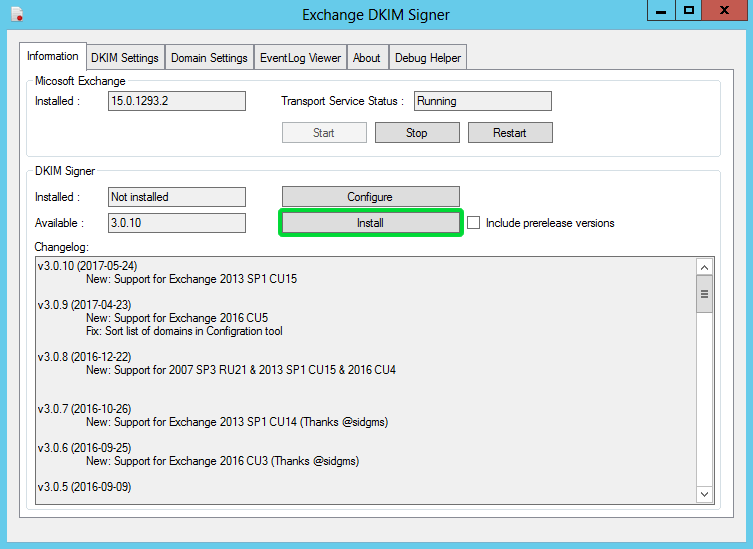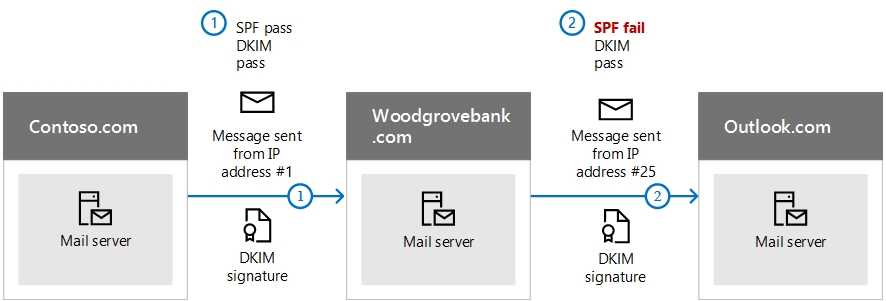How Generate Dkim Key For Microsoft Exchange
Last week one of the known load balancer company send me an email where sender and recipient email address were my domain’s email addresses on my office 3 65. In the post incident RCA Microsoft told that SPF is not enough for this incident and we should have DKIM enabled for our domains.
- How Generate Dkim Key For Microsoft Exchange Free
- Dkim Microsoft Docs
- How Generate Dkim Key For Microsoft Exchange 2017
- How Generate Dkim Key For Microsoft Exchange 2016
- How Generate Dkim Key For Microsoft Exchange Free
Microsoft recommends to create DKIM DNS record along with SPF which adds the digital signature. Check Microsoft TechNet Blog here to learn more.
Overall it is a 2 step process. First is the creation of 2 CNAME records and second is Enabling DKIM in office 365 which will create 2 DKIM TXT record. The key here is learning how to create Cname record.
- That means that I have access to your private key, and could forge email to appear to be from you. I'm not going to do that, of course, but if you're concerned about the risk then you can generate DKIM Core keys on your own machine using openssl, as described in the specification.
- In this article Syntax Get-DkimSigningConfig -Identity Description. DKIM in Microsoft Office 365 is an email authentication method that uses a public key infrastructure (PKI), message headers and CNAME records in DNS to authenticate the message sender, which is stamped in the DKIM-Signature header field.
Apr 07, 2020 To enable DKIM, signing for your domain through the Exchange admin center. Sign into EAC with an admin account. Go to protection dkim. Select the domain for which you want to enable DKIM and then, for Sign messages for this domain with DKIM signatures, choose Enable. Jul 19, 2017 Now switch to the Domain Settings Tab. Fill in your Domain name and Selector and click Generate new key. DKIM Signer will then generate new public and private DKIM signing keys based on your chosen domain and selector. A save window will open prompting you to save the newly generated key in 'C:Program FilesExchange DkimSignerkeys'.
I am sharing the following steps to enable DKIM record in Office 365.
- Create 2 CNAME record else you will see the below warning:
CNAME record does not exist for this config. Please publish the following two CNAME records first.
selector1-emaildomainname._domainkey.Tenantename.onmicrosoft.com
selector2-emaildomainname._domainkey.Tenantename.onmicrosoft.com
- Login to your office 365 tenant
- Open the Exchange Admin Center à Protection à DKIM à Select the domain and click Enable
Or
- Click on Security Policies à DKIM à Select the domain and click Enable
We do not need to rotate the Key. Microsoft does it for us.
For the verification, I had sent an email to MSExchangeGuru.com email address and the successful DKIM validation.
This is how my previous email used to look like.
Even though my sender domain is not onmirosoft.com, it used to pick up our tenant domain. This means it was using the default signature created by Microsoft but it is not 100 secure so you should configure DKIM for your domain.
Now the question is where are my DKIM record. It is simple logic. We created 2 Cname record which are the alias records so it will go to the pointers under Tenantename.onmicrosoft.com which is owned by Microsoft so you can’t see it in your DNS provider list.
There are couple of ways to check them
- Login to your office 365 à Settings à Domains à Select your domain à Additional Office 365 records.
Or
- Open command prompt à Nslookupà Set q=txtà Then type the pointer and enter
The crew license key generator.

- We can also test the DKIM record working here. http://dkimcore.org/tools/keycheck.html
Just fill like this and click check
YAY! This is a valid DKIM key record
We are done DKIM for Office 365 here. I know some of you will ask to provide a blog for on premise, expect it sooner.
I am also sharing couple of reference here.
How anti spoofing protection works in Office 365 Mail http://aka.ms/AntiSpoofingInOffice365
https://blogs.msdn.microsoft.com/tzink/2016/03/07/a-powershell-script-to-help-you-validate-your-dkim-config-in-office-365/
Prabhat Nigam
Microsoft MVP CTO @ Golden Five
How Generate Dkim Key For Microsoft Exchange Free
Team@MSExchangeGuru
Spoofing is a common challenge that enterprises face in today’s world, which can lead to increased spam and more intensified phishing campaigns. In order to reduce spoofing and provide a safer client experience, Office 365 now supports inbound validation of DomainKeys Identified Mail (DKIM) over IPv4, and Domain-based Messaging and Reporting Compliance (DMARC). Both of these technologies check for trusted authenticated senders and help identify untrusted ones that that fail authentication. Exchange Online Protection (EOP), which filters every single mailbox on Office 365, had previously supported Inbound DKIM for IPV6. With these added functionalities feature, Office 365 users can expect better brand protection and an even safer experience.
Let’s take a closer look at these new service features.
Domain-based Messaging and Reporting Compliance (DMARC)
DMARC is a technology designed to combat email spoofing and is useful to stop phishing. Specifically, it protects the case where a phisher has spoofed the 5322.From email address, which is the email address displayed in mail clients like Outlook and outlook.com. Whereas the Sender Policy Framework, (SPF) catches the case where the phisher spoofs the 5321.MailFrom, which is where bounce messages are directed, DMARC catches the case that is more deceptive.
A phishing message spoofing a financial institution but failing DMARC.
DMARC protects users by evaluating both SPF and DKIM and then determines if either domains matches the domain in the 5322.From address. In the example above, the phisher has passed SPF for phishing.com, but because phishing.com does not equal woodgrovebank.com, it fails DMARC.
The results of a DMARC check are stamped in the Authentication-Results header:
Office 365 then uses DMARC to mark the message as spam and provide better protection for its users. For more details, please see the blog post, Using DMARC in Office 365.
Dkim Microsoft Docs
DomainKeys Identified Mail (DKIM)
DKIM permits the person, role or organization, who owns the signing domain, to claim some responsibility for a message by associating the domain with the message. Senders insert a digital signature into the message in the DKIM-Signature header, which receivers then verify. DKIM allows senders to build domain reputation, which is important to ensure email delivery and provides senders a non-spoofable way to identify themselves. It is a critical component of email protection. Office 365 previously supported DKIM when a message was sent over IPv6 and now supports it when it is sent over IPv4.
How Generate Dkim Key For Microsoft Exchange 2017
The results of a DKIM verification are written to the Authentication-Results header. For example, if the signing domain in the d= field in the DKIM-Signature header is d=example.com:
If a message fails DKIM verification, the header will say dkim=fail with the reason for the failure in parentheses, for example invalid body hash, key query timeout, no key for signature, and so forth.

Office 365 verifies DKIM signatures when receiving the message. However, after the message has been scanned, (lands in a user inbox, or is relayed to an on-premises mail server, is bcc’ed via a policy rule and so forth), the existing DKIM-Signature may no longer verify if a downstream mail server tries to re-verify it. This is because Office 365 modifies some parts of the message. We will be changing this behaviors in a subsequent release of Exchange Online Protection.
How Generate Dkim Key For Microsoft Exchange 2016
For more information on DKIM, please see RFC 6376 and dkim.org.
A message with a digital signature attached.
These two features are currently being rolled about and will be fully deployed by the end of the first quarter of 2015.These features help improve the Office 365 experience by helping reduce both phishing and spam in the service and we look forward to more secure experiences as we continue to add new capabilities to Exchange Online Protection (EOP).
How Generate Dkim Key For Microsoft Exchange Free
—Terry Zink is a program manager and Shobhit Sahay is a technical product manager on the Office 365 team.